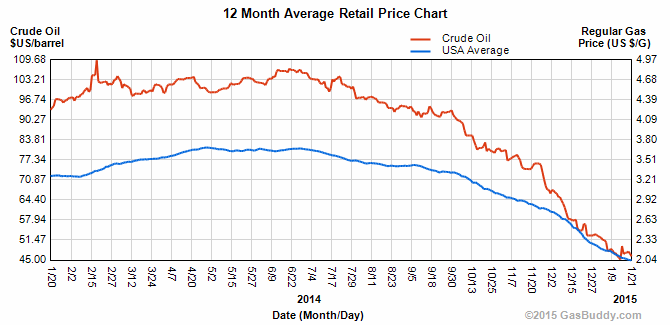Gas prices affect the cost of the goods we buy, how we heat our homes and especially, how often we travel throughout the year. With prices dropping, quite significantly I might add, the question is, has this decrease helped the travel industry and travelers themselves?
Just a little under a year ago the average price of a gallon of gas across the United States was right around $4.00. A quick look at a historical chart presented by GasBuddy.com shows that the national average topped out around $3.70 in the month of April 2014. Many assumed that the price would continue to rise, causing price increases in just about everything.
Recently however, since the month of September, gas prices nation-wide have been falling, so much so that the national average as of today is $2.04 a gallon. Some places, like Oklahoma City, Oklahoma are now under the $2.00 mark and seeing prices as low as $1.73 per gallon. 2014 finished off with gas prices that Americans haven’t seen since May of 2009, some four years ago.
Crude Oil, which was once as high as $110 per barrel is now being sold at around half that cost. Take a look at the chart below showing both the crude oil prices (shown in red) and the gas prices (shown in blue), you’ll notice that there has been a sharp drop off for both on the graph.

What does this mean for the traveler?
Good things.
According to the United States Energy Information Administration (EIA), family households are projected to spend $750 less on gasoline costs in 2015. Which means more money in the pockets of many Americans.
The average household is expected to spend about $750 less for #gasoline in 2015 compared with last year #STEO http://t.co/O3IwFoBABn
— EIA (@EIAgov) January 13, 2015
Extra money means the ability to spend on other things.
“The demand for gasoline is very price inelastic over short time periods, meaning changes in price have little impact on the number of gallons used,” according to the EIA website. “Falling gasoline prices allow households to spend their income on other goods and services, pay down debt, and/or increase savings.”
The falling prices have already made an impact in the lives of many Americans, as evidenced by the 2014 end of year holiday travel. AAA reports that the holiday travel numbers are expected to total 98.6 million people, which is an increase from the 94.8 million who traveled in 2013. According to AAA, this will be the highest amount recorded since 2001, roughly 14 years ago.
With 91 percent of the total travelers during the holiday season being road-trippers, you can be sure that the dip in fuel prices has had a major impact. AAA goes on to mention that without the drop in prices, these numbers may not have been attainable.
“Today’s national average price of gasoline is at the lowest level in five years and 70 cents lower than last year, a welcome gift for holiday travelers. Gas prices have fallen for 82 days in a row, helping to increase Americans’ disposable income 3.5 percent from year-ago levels, which has had a positive effect on travel.”
A number of things are having an impact on why the gas prices are projected to stay low for the year of 2015. A pretty-much natural-disaster free 2014 in the Gulf of Mexico has allowed companies to produce oil all year long, keeping up with and exceeding demands. Couple that with new processes and drilling sites and you can understand how the United States has been able to increase its oil production every year since 2008.
Despite the good news for automobile travel, it doesn’t appear to have translated well in the realm of air travel.
CBS reports that in the third quarter of 2014 jet fuel prices dropped nearly six percent, which caused a large gain in profits for the major airlines. Southwest saw a gain of 27 percent, American recorded a record 87 percent and United saw profits that were 144% better than the previous year.
Fourth-quarter jet fuel prices dropped nearly 25 percent, however the price of airfare has not decreased. In fact, findings show that as long as demand for air travel remains high the prices could actually increase. U.S. air carriers are projected to make $13 billion dollars in profits this year, due in part to low fuel costs, however their operating costs continue to rise, increasing three percent in 2014 alone. So the question is, will any of these savings be passed on to the customers? The first airline that does offer a discounted rate will be sure to be hailed as a rock star among the travelers of the world.
Obviously booking in advance can help to offset the higher costs of airfare. My own research shows that the same flight, from Philadelphia to Los Angeles, can differ based on when you book. If I book today, Jan 21, for a flight that leaves February 22 and returns on the 28, it will cost me $254. That same flight, booked to depart on January 22 and return on the 28, would cost me $325. A difference of $71 dollars per ticket.
Whether or not the falling fuel prices affect the major airlines and bus companies is yet to be seen, however they certainly have had a positive effect on road travel.
So will 2015 be the year of the Road-Trip? That still remains to be seen, but these ever-falling gas prices will continue to fuel everyday Americans and their abilities to spend money in other areas, including travel.
For more information, updates, travel tips and news from Sundance Vacations, be sure to follow us on the following social media outlets:
- Sundance Vacations Facebook
- Sundance Vacations Twitter
- Sundance Vacations Instagram
- Sundance Vacations YouTube

